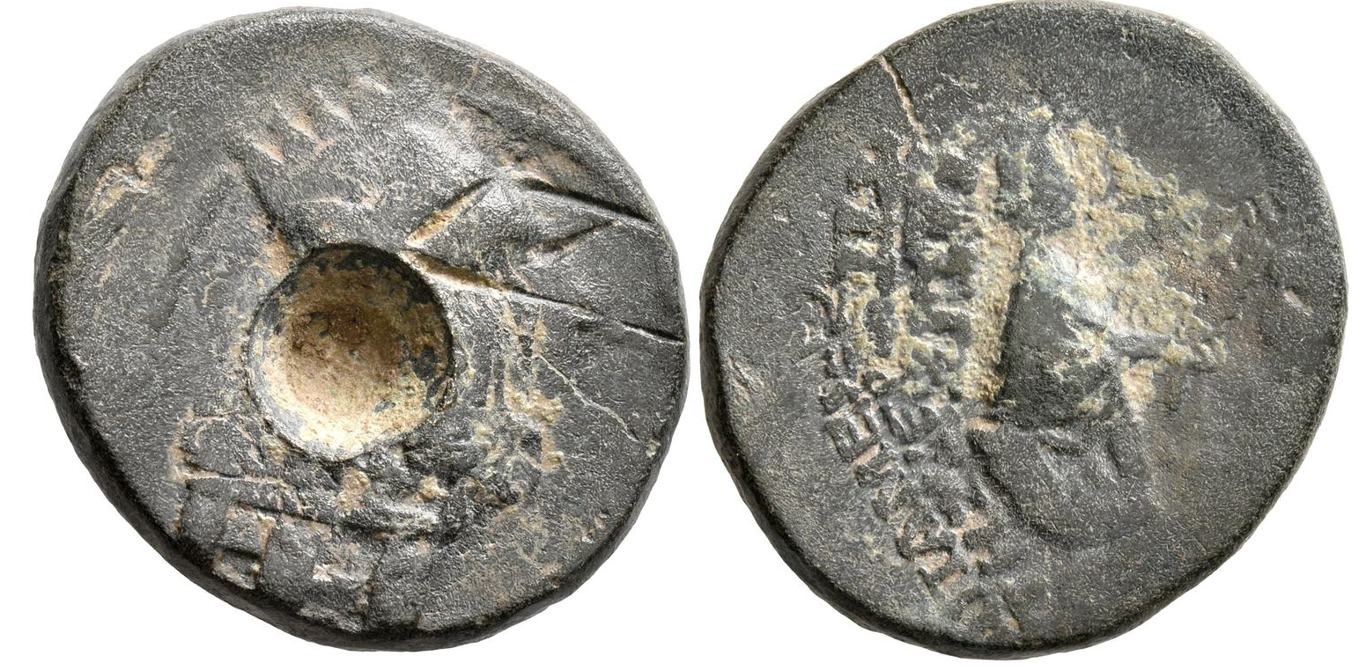80 BCE - 68 BCE | BAΣIΛEΩΣ BAΣIΛEΩN TIΓPANOY
Overstriking coin
Tigranocerta_over_Apameia_(Leu_Numismatik, _5, _2018, _n°349).PNG
[1]
Overstruck variety
Apameia_Tyche_Nike.JPG
[2]
|
|
Sale(s)Sale(s) ᵖ:
|
Leu Numismatik, EA 5, 23 Sept. 2018, 349 = Leu Numismatik, EA 7, 23 Feb. 2019, 470
|
|
|
|
Description
| ObverseInscription or printing placed on the obverse.:
|
Bust of Tigranes II to right, wearing Armenian tiara decorated with a star between two eagles and tied with a diadem, drapery on shoulders. Border of dots.
|
ReverseInscription or printing placed on the reverse.:
|
BAΣIΛEΩΣ BAΣIΛEΩN TIΓPANOY (Greek) Tyche of Tigranokerta seated to right on rock, holding palm branch in her right hand, below, river-god Araxes swimming right.
|
Mint and issuing power
Chronology
| FromIdentifies the initial date in a range assigned in a numismatic context. 80 BCE toIdentifies the final date in a range assigned in a numismatic context.. 68 BCE
|
Hellenistic 323-30 BC  periodTime period of the numismatic object. periodTime period of the numismatic object.
|
Physical description
MetalThe physical material (usually metal) from which an object is made.: Bronze 
|
WeightWeight of the numismatic object (in grams). in grams: 7.967.96 g <br />7,960 mg <br />
|
DenominationTerm indicating the value of a numismatic object. Examples: tetradrachm, chalkous, denarius.: tetrachalkon 
|
AxisDescribes the directional relationship between the obverse and reverse of a numismatic object.: 1212 mm <br />1.2 cm <br />
|
| DiameterDescribes diameter of an object (in mm).: 2323 mm <br />2.3 cm <br />
|
|
References
Description
| ObverseInscription or printing placed on the obverse.:
|
The upper part of the turreted city-goddess is visible
|
ReverseInscription or printing placed on the reverse.:
|
ΑΠΑΜΕΑΩΝ ΤΗΣ ΙΕΡΑΣ ΚΑΙ ΑΣΥΛΟΥ (Greek) The beginning of the legend is visible
|
Mint and issuing power
| MintIdentifies the place of manufacture or issue of a numismatic object. ᵖ:
|
Apameia
|
Ancient regionAncient region. ᵖ
|
Syria
|
Modern countryModern country: Syria
|
AuthorityIdentifies the authority in whose name (explicitly or implicitly) a numismatic object was issued. ᵖ:
|
|
Chronology
| FromIdentifies the initial date in a range assigned in a numismatic context. 70 BCE toIdentifies the final date in a range assigned in a numismatic context.. 69 BCE
|
Hellenistic 323-30 BC  periodTime period of the numismatic object. periodTime period of the numismatic object.
|
Physical description
References
| Frequency of overstrikesFrequency of overstrikes:
|
frequent
|
Level of confidenceLevel of confidence of the identification:
|
sure
|
| RemarksRemarks:
|
"The upper part of the turreted city-goddess is still visible on the obverse, whereas the reverse shows the beginning of the reverse legend: AΠAMEΩN / THΣ IEΡA[Σ - KAI AΣΥΛOΥ] "
|
References
- ^ Bedoukian, Paul Z. (1978), Coinage of the Artaxiads of Armenia, RNS Special Publication Number 10, London, 81 p.
- ^ Nercessian, Yeghia T. (1995), Armenian Coins and Their Values, Armenian Numismatic Society Special Publication 8, Los Angeles.
- ^ Kovacs, Frank (2016), Armenian coinage in the classical period, Classical Numismatic Studies 10, Lancaster, 83 p.
- ^ Hoover, Oliver D. (2009), Handbook of ancient Syrian coins : royal and civic issues, fourth to first centuries BC, The Handbook of Greek Coinage 9, Lancaster, lxix, 332 p.